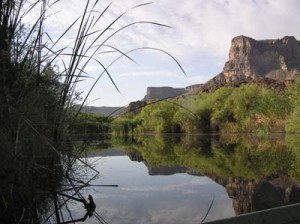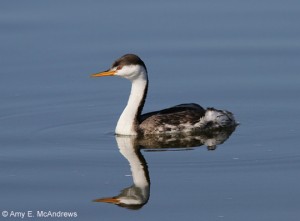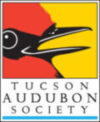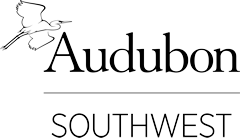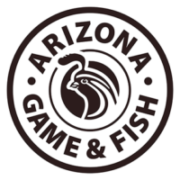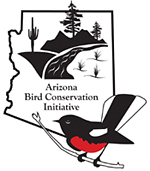Global IBA for Bell’s Vireo and Black Rail
Continental IBA for Yuma Ridgway’s Rail and Clark’s Grebe
Size: 9.4 square miles, 6000 acres
Identified: 01/2004. Global: 10/2010. Continental: 10/2011
Visiting the IBA: To get to Bill Williams River NWR from Lake Havasu City, Arizona follow Arizona Highway 95 south approximately 23 miles. Headquarters are located between mileposts 160 and 161.
Ownership: U.S. Fish and Wildlife Service
Site Description: The Bill Williams River National Wildlife Refuge, the IBA, a nine-mile corridor and delta, is the last extensive naturally flood-regenerated riparian and wetlands habitat on the Lower Colorado River.
This riparian zone is an area of year around available water and riparian vegetation creating cooler, more humid conditions than the surrounding desert where rainfall averages only 3 inches per year and summer temperature often exceed 120 degrees.
Habitats consist of extensive mesquite bosque and desert uplands, as well as cottonwood-willow, bulrush, cattail, and seep willow.
Birds: The refuge provides breeding habitat for 25 species of conservation concern in Arizona. These species nesting in the IBA include federally listed endangered and threatened species, i.e., Southwestern Willow Flycatcher and Yuma Ridgway’s Rail; Arizona Partners in Flight High Priority species, i.e., Western Yellow-billed Cuckoo, American Bittern, and Lucy’s Warbler; and Audubon Watch List, Red Listed species, i.e., California Black Rail, Bell’s Vireo and Bendire’s Thrasher. Two other breeders within the IBA, Clark’s Grebe and Yellow Warbler (D. petechia sonorana), are also listed as species of concern by the state of Arizona and US Fish and Wildlife Service (Birds of Conservation Concern), respectively. This IBA is one of the few areas left on the Lower Colorado River with large breeding populations of warblers, particularly Yellow and Lucy’s and Yellow-breasted Chats, as well as other riparian obligate species.
Peregrines breeding in the vicinity of the refuge use habitats within the refuge after they fledge. Crissal, Bendire’s and Curve Billed Thrashers, (USFWS and Audubon Yellow Listed, birds of conservation concern) breed in the riparian edges and mesquite bosque as well. Overall 343 species have been recorded on the refuge.
Species of special conservation status and interest that use the habitats within this IBA include:
Breeding: California Black Rail, Yuma Ridgway’s Rail, American Bittern, Clark’s Grebe, Cooper’s Hawk, Elf Owl, Burrowing Owl, Snowy Egret, Great Egret Southwestern Willow Flycatcher, Western Yellow-billed Cuckoo, Bell’s Vireo, Crissal, Bendire’s and Curve Billed Thrashers, Lucy’s Warbler, Yellow Warbler, Yellow-breasted Chat. Bell’s Vireo estimated numbers is 2700 individual birds.
Migration: American Avocet, Western Grebe, Tree Swallow, Peregrine Falcon, Merlin, Bald Eagle.
Conservation Concerns: Wind energy development, grazing and off highway vehicle travel. Strategies: Colorado River Multi-Species Management Plan, no recreational watercraft allowed in marsh habitat, designation as a national wildlife refuge.
Conservation Stewards: Bill Williams River National Wildlife Refuge Friends and Prescott Audubon Society.
www.fws.gov/southwest/refuges/arizona/billwill.html
Mini Conservation Plan
Complete eBird.org Checklist of birds Reported for Bill Williams River National Wildlife Refuge IBA
Location: 34.2891° N: 114.0744° W
County: La Paz
Site Status: Identified 10/2004, Identified as Continental 10/2011, Identified as Global 10/2010
Ownership: US Fish and Wildlife Service
Area: 9.4 square miles, 6,000 acres
Criteria: A1: Global: Species of Conservation Concern (Black Rail and Bell’s Vireo)
A4i: Global Concentration – Clark’s Grebe 475 individuals 2011
B1: Continental: Species of Conservation Concern (Yuma Ridgway’s Rail and Yellow-billed Cuckoo)
D1: State: Species of Conservation Concern
D3: State: Species in rare/unique habitat
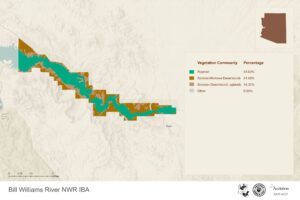 Site Description: The Bill Williams River National Wildlife Refuge, the IBA, a nine-mile corridor and delta, is the last extensive naturally flood-regenerated riparian and wetland habitat on the Lower Colorado River. This riparian zone is an area of year-around available water and riparian vegetation creating cooler, more humid conditions than the surrounding desert where rainfall averages only 3 inches per year and summer temperature often exceed 120 degrees. In the winter the warmth allows many plants to keep their leaves, others to bloom in December and January, and the insects to remain active, all of which makes it a vital stopover for migration and wintering of birds on the Colorado River Flyway. The Bill Williams River National Wildlife Refuge is the steward for this site. Information about the refuge can be found at http://www.fws.gov/southwest/refuges/arizona/billwill.html
Site Description: The Bill Williams River National Wildlife Refuge, the IBA, a nine-mile corridor and delta, is the last extensive naturally flood-regenerated riparian and wetland habitat on the Lower Colorado River. This riparian zone is an area of year-around available water and riparian vegetation creating cooler, more humid conditions than the surrounding desert where rainfall averages only 3 inches per year and summer temperature often exceed 120 degrees. In the winter the warmth allows many plants to keep their leaves, others to bloom in December and January, and the insects to remain active, all of which makes it a vital stopover for migration and wintering of birds on the Colorado River Flyway. The Bill Williams River National Wildlife Refuge is the steward for this site. Information about the refuge can be found at http://www.fws.gov/southwest/refuges/arizona/billwill.html
| Vegetation Description | Hectares |
| COTTONWOOD – WILLOW COMMUNITIES | 429.5004 |
| DALEA SPINOSA ASSOCIATIONS | 2261.529 |
| MIXED MICROPHYLL TREE ASSOCIATIONS | 1930087 |
| MIXED PALOVERDE – CACTI COMMUNITIES | 1929900 |
| REED COMMUNITES | 116.9732 |
| TAMARIX PENTANDRA ASSOCIATIONS | 12.12488 |
Ornithological Summary:
| Species or group | Season | Maximum | Year |
| Black Rail | Breeding | 15 Pairs | 2000 |
| Yuma Ridgway’s Rail | Breeding | 10 Pairs | 2003 |
| Yellow-billed Cuckoo | Breeding | 30 Pairs | 2001 |
| SW Willow Flycatcher | Breeding | 7 Pairs | 2003 |
| Clark’s Grebe
Clark’s Grebe |
Breeding
Non-breeding |
44 Pairs
475 Individuals |
2000
2011 |
Other Flora and Fauna: Due to the unique natural regeneration of the complex riparian plant communities and its position on the ecotone between the Sonoran and Mohave deserts, an extensive and diverse invertebrate fauna is also present on the Bill Williams River. For example, 11 species of butterflies are present that were once common on the Lower Colorado River before the dams, but are now found only on the refuge, two more species are common here but rare otherwise. Other native species of invertebrates are doubtless equally well represented. Virtually the entire complex of species native to the Lower Colorado River historically are still present on the Bill Williams River NWR including 53 mammals from Desert Shrews to Desert Bighorns and from Pocket mice to Mountain Lions. The bats are particularly well represented with several rare forest dependent species present. Likewise the reptile and amphibian diversity is equally high (30 species) including the rare Lowland Leopard Frog, Desert Tortoise and numerous species of lizards and snakes. The endangered Razorback Sucker and Bonytail Chub are also present in the delta along with many introduced fish species.
Conservation Issues:
Threats may include upstream water diversions, wildfire, invasive exotic species spreading into riparian habitat along river, particularly Tamarix ramosissima, and excessive or inappropriate public recreation. The Threat Importance of animal and plant introductions is high.

